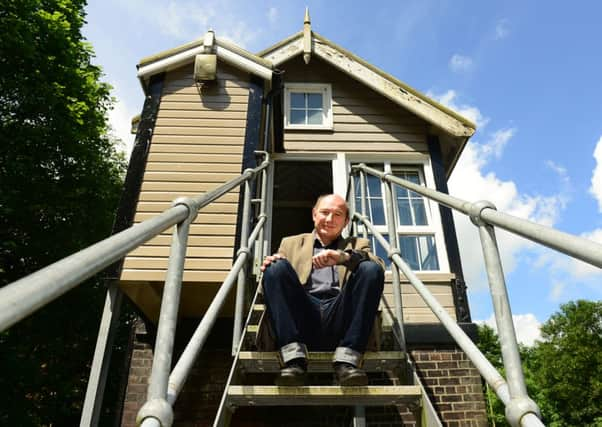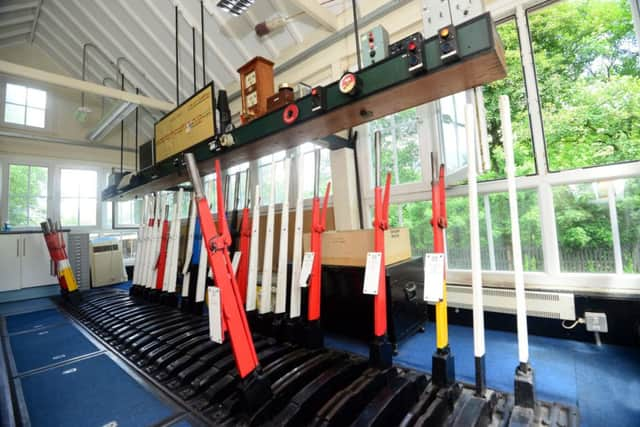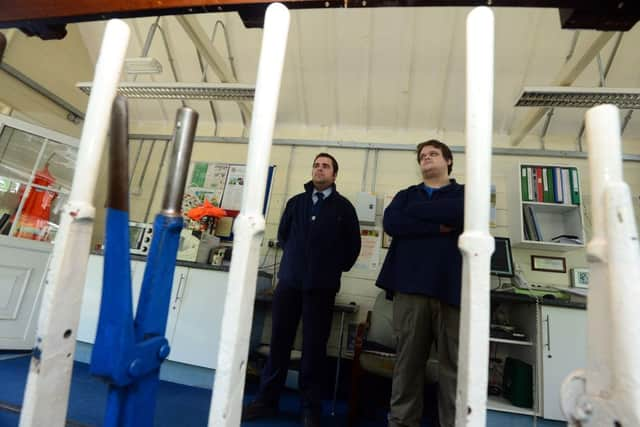Points of no return


Between the 11.20 to Leeds and the 11.42 to Manchester Victoria, Colin Cooper is reflecting on the loneliness of the long-distance signalman. “Signalling is a job for someone who likes their own company,” he says. “On some shifts you may see no-one for 12 hours.”
There’s not much chance of loneliness today for Paul Sutcliffe up here in the signal box at Hebden Bridge station – an elite example, recently added to the tally of Chosen Ones, listed for their architectural or historic importance by English Heritage.
Advertisement
Hide AdAdvertisement
Hide AdIn signal box terms this is a crush: signalman Paul, Colin (mobile operations manager with Network Rail), John Minnis (the English Heritage senior investigator who recommended the listing), a Yorkshire Post photographer, a Network Rail press officer, me and an awful lot of memories.


Paul takes it all in his stride. With little bells tinging and lights flashing, he heaves great Victorian cast-iron levers (mysteriously labelled “FPL No 24 points: ‘A’ End Only” or “Down Main to Down – Limit of Shunt”). He pulls them and pushes them to change points and signals and, in the occasional lull, joins the discussion.
So how lonely can it be in a signal box? “It’s fine being in this box; you’ve got civilisation around you,” he says. “But some boxes can be very isolated and a little lonely. You might have one in a cutting and that can be disconcerting at night with animals bobbing about, and birds.”
Colin, himself a former signalman, mentions the ultra-isolated Blea Moor box at Ribblehead on the Settle-Carlisle line: half a mile from the nearest road. We talk about how boxes on the Harrogate line between Knaresborough and York have only two trains an hour passing. And John Minnis beams like a man entirely in his element, quietly thrilled to be in Hebden Bridge signal box as the 11.42 to Manchester draws to a halt at the platform.
Advertisement
Hide AdAdvertisement
Hide AdThese are tricky times for signal boxes. In 1900, some 10,000 of them were scattered across Britain. The infamous Beeching report that closed so many branch lines 50 years ago slashed that number by half.


Now just 500 traditional boxes are still in use and most will be closed within 30 years as the network’s signalling is modernised and will be run from 12 regional centres. And that will probably be the point at which the traditional signallers’ way of measuring distance – miles, yards, feet and chains – finally gives way to kilometres.
English Heritage was alarmed that the closures may spell the end for important boxes, so, working with Network Rail, it launched the Signal Box Project to “capture a snapshot of the Victorian heyday of railways for future generations”.
That’s where John Minnis comes in. An architectural historian (he has co-written the Pevsner Architectural Guide to Sheffield), he surveyed the surviving boxes – many still with original operating equipment - with a view to adding to the 85 already listed. Those included a dozen across Yorkshire – Beverley, Keighley, Pickering, Scarborough and Knaresborough among them.
Advertisement
Hide AdAdvertisement
Hide Ad“One of the big problems with these buildings is what to do with them,” says John. Some have been turned into museums, booking offices, holiday lets, artists’ studios and cafes (including one on the passenger bridge at York station).
No-one will deny the period charm of signal boxes, squatting beside lines like little railway doll’s houses with picture windows, nostalgically recalling the long-lost days of cheery porters and stout station masters with heavy fob-watches.
But do the boxes deserve to be dignified with listing, up there with castles, stately homes and cathedrals? John thinks they do, and has no doubts about their appeal and importance.
“It’s the marriage of form and function,” he says. “In a sense they’re very utilitarian – a way of covering mechanical equipment and providing space for the people who operate it. But often they do this in ways that are very ornate. They’re very visible buildings; the railway companies thought they should be ‘seemly’, and in the early days they were very much in the picturesque tradition. And they encapsulate so many aspects of Victorian architecture.”
Advertisement
Hide AdAdvertisement
Hide AdHe bore all that in mind, together with the need to preserve representative examples of as many box types as possible, preferably unaltered over the years. He’s pretty pragmatic, though, about modernisations – “You can’t expect people in the 21st century to carry on working in 19th century conditions” – and found that many of the best-preserved boxes are on “heritage” lines.
He sifted through boxes built to Saxby & Farmer Type 5 designs, McKenzie and Holland Types Ones, and London, Midland and Scottish Railway Type Fours. He noted bargeboards and finials, valencing, eaves brackets and half-hipped roofs. He discovered such delightful railway names as Monk’s Siding, Rowley Regis and Bobeep Junction (watch out for sheep).
And he recommended 50 or so boxes – dating from the 1870s to the 1920s – for listing, including six in the Yorkshire area: Settle; Hensall, near Selby, Hammerton and Marston Moor, near Harrogate; Nunthorpe, near Middlesbrough; and Hebden Bridge.
As the 11.49 to Leeds passes, John gazes round the Hebden box – built in 1891 – like a church enthusiast taking in a fine bit of Perpendicular. “A very attractive building, a building of great character,” he says. “A very ornate structure. A classic signal box. And it’s been very nicely restored. Look, care’s been taken to make the toilet blend in, with its own little finial.”
Advertisement
Hide AdAdvertisement
Hide AdWe leave Paul in his box, with his kettle and microwave and his jars of coffee and tea, like a home from home, and walk along the platform, a period treasure with its fretwork canopies and its pillars painted two-tone brown and its signs with square solid lettering, white-on-black, proudly proclaiming “Hebden Bridge” or instructing: “Passengers must not cross the line except by the subway” (a finger points down). The voice over the public address system – “This is a customer announcement” – comes as a bit of a modern shock.
“You have this wonderful time-warped station that has somehow retained so many of its original features,” says John. “It’s extraordinary in this neck of the woods because so many stations only have a sort of bus shelter on them. One of the factors we took into account is the concept of “group value” – the contribution that one building makes to the whole group of buildings. Here the signal box is contributing to the whole 19th century railway environment.”
Just as the stations on the Settle-Carlisle line – creating a complete period world of rail travel – are cherished, so is Hebden, not least by its Friends group. It has tubs of geraniums and window boxes of petunias and permanent heritage exhibitions.
Vintage posters reveal “Beauty spots of Hedben Bridge”, a destination “for picnic parties from all over Lancashire and Yorkshire” and there’s an 1844 advert for a “Cheap Trip to Hull” . “The company will convey a limited number of passengers in open waggons to Hull and back the same day,” it says. Depart 6am, return 5pm. Fare three shillings (when a skilled mill worker’s weekly wage was 15 shillings). Compare a 1957 Saturday excursion from Bradford to Blackpool – depart 1.25pm, arrive back at 1.56am on the Sunday, and straight to bed.
Advertisement
Hide AdAdvertisement
Hide AdHere, for the delight of hardcore enthusiasts, are photographs of Luddenden Foot Goods Yard in 1900 and Mytholmroyd sorting sidings and Todmorden viaduct.
And there’s a sniffy cutting from the Halifax Guardian in 1871 about Mytholmroyd station, which had a First Class waiting room and a “general” one: “First class passengers will have to pass through the general waiting room before they can reach their room; this is a very objectionable feature in their construction.”
I point out to John that not everyone in the 19th century was thrilled by the coming of the railways. “The whole face of the kingdom is to be tattooed with these deformities,” thundered one magazine. “The noise and stench of steam locomotives are to disturb the quietude of the peasant, the farmer and the gentleman.”
So what would Nikolaus Pevsner, the high priest of architectural appraisal, have made of signal boxes being listed? “He once drew a distinction between ‘a building’ and ‘architecture’,” says John. “He said Lincoln Cathedral was architecture but a bike shed was a building. I think he might have thought signal boxes were more buildings than architecture.”
But such heretical thoughts are swept aside by the 12.05 to Manchester.